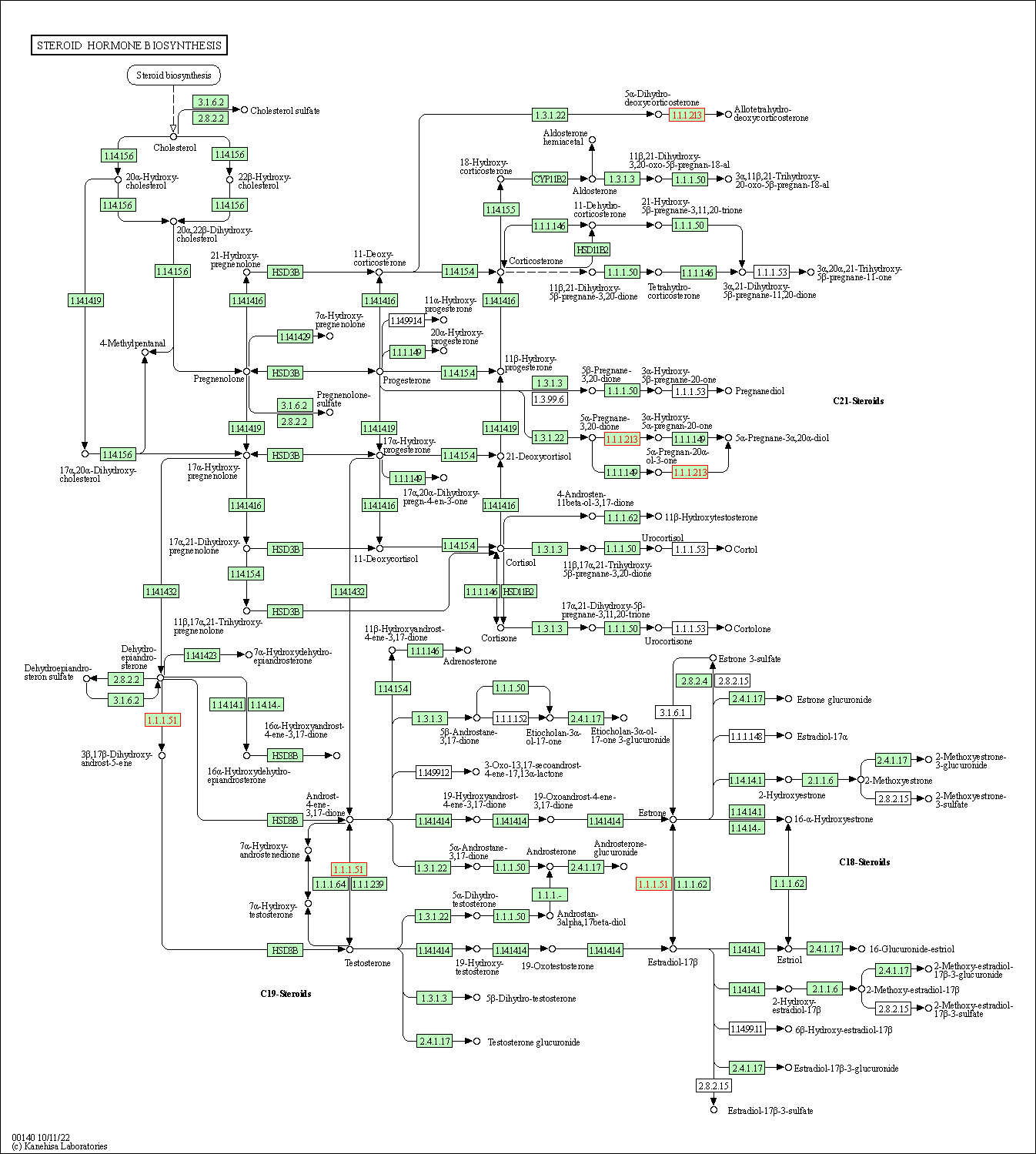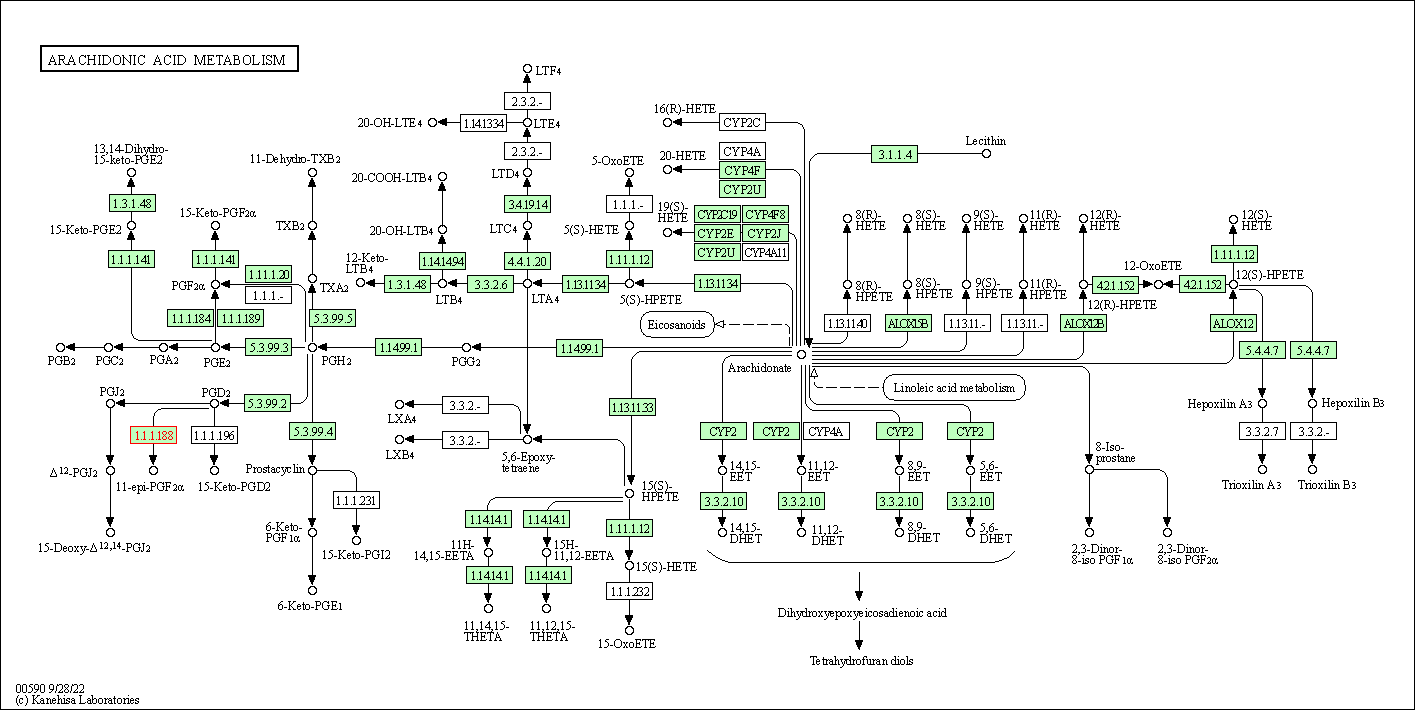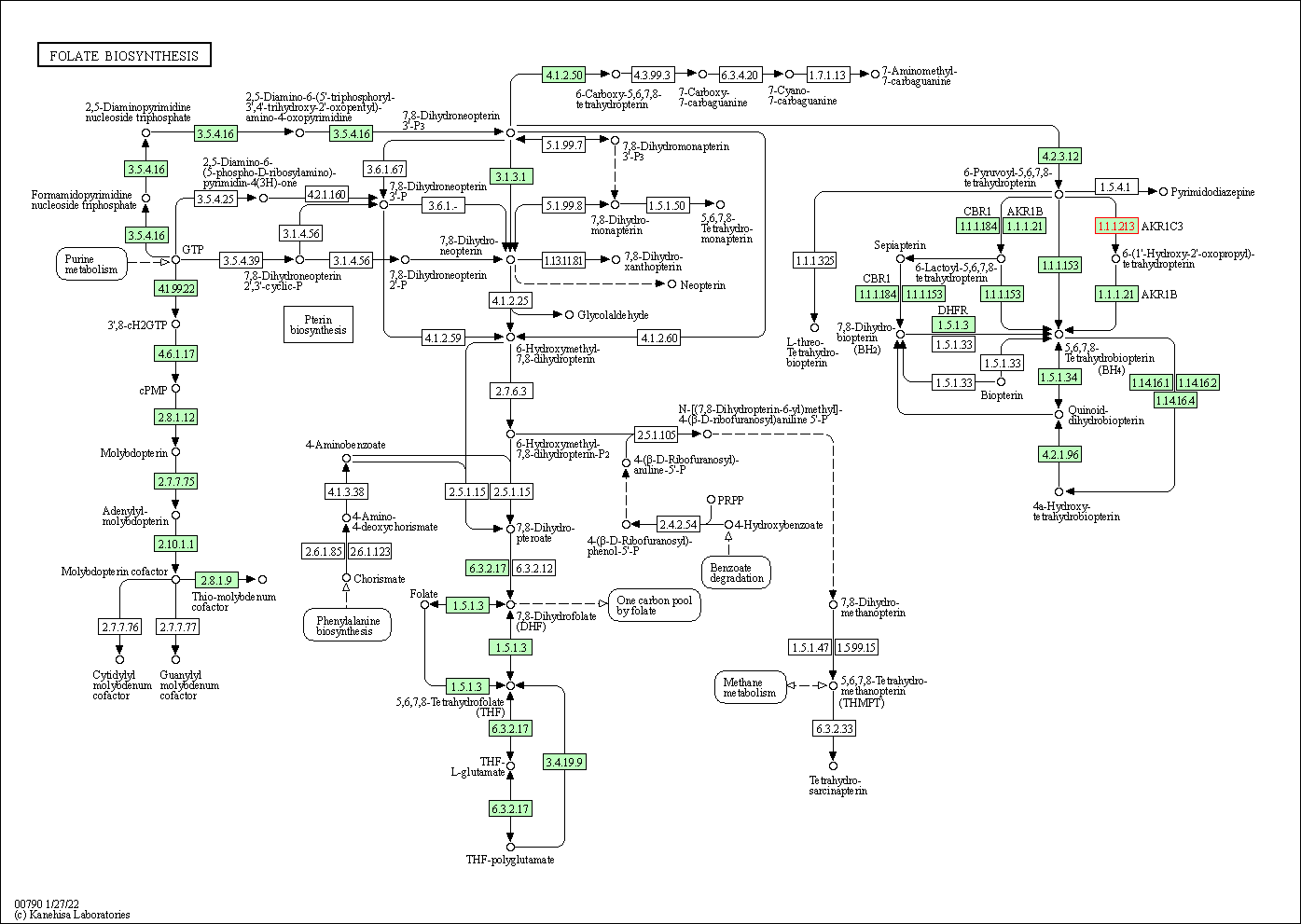Target Information
| Target General Information | Top | |||||
|---|---|---|---|---|---|---|
| Target ID |
T60857
(Former ID: TTDR00033)
|
|||||
| Target Name |
Dihydrodiol dehydrogenase type I (AKR1C3)
|
|||||
| Synonyms |
Trans-1,2-dihydrobenzene-1,2-diol dehydrogenase; Testosterone 17-beta-dehydrogenase 5; Prostaglandin F synthase; PGFS; KIAA0119; Indanol dehydrogenase; HSD17B5; HA1753; Dihydrodiol dehydrogenase 3; DDH1; DD3; DD-3; Chlordecone reductase homolog HAKRb; Aldo-keto reductase family 1 member C3; 3-alpha-hydroxysteroid dehydrogenase type 2; 3-alpha-HSD type II, brain; 3-alpha-HSD type 2; 17-beta-hydroxysteroid dehydrogenase type 5; 17-beta-HSD 5
Click to Show/Hide
|
|||||
| Gene Name |
AKR1C3
|
|||||
| Target Type |
Successful target
|
[1] | ||||
| Disease | [+] 1 Target-related Diseases | + | ||||
| 1 | Female pelvic pain [ICD-11: GA34] | |||||
| Function |
Catalyzes the conversion of aldehydes and ketones to alcohols. Catalyzes the reduction of prostaglandin (PG) D2, PGH2 and phenanthrenequinone (PQ) and the oxidation of 9-alpha,11-beta-PGF2 to PGD2. Functions as a bi-directional 3-alpha-, 17-beta- and 20-alpha HSD. Can interconvert active androgens, estrogens and progestins with their cognate inactive metabolites. Preferentially transforms androstenedione (4-dione) to testosterone.
Click to Show/Hide
|
|||||
| BioChemical Class |
Short-chain dehydrogenases reductase
|
|||||
| UniProt ID | ||||||
| EC Number |
EC 1.-.-.-
|
|||||
| Sequence |
MDSKHQCVKLNDGHFMPVLGFGTYAPPEVPRSKALEVTKLAIEAGFRHIDSAHLYNNEEQ
VGLAIRSKIADGSVKREDIFYTSKLWSTFHRPELVRPALENSLKKAQLDYVDLYLIHSPM SLKPGEELSPTDENGKVIFDIVDLCTTWEAMEKCKDAGLAKSIGVSNFNRRQLEMILNKP GLKYKPVCNQVECHPYFNRSKLLDFCKSKDIVLVAYSALGSQRDKRWVDPNSPVLLEDPV LCALAKKHKRTPALIALRYQLQRGVVVLAKSYNEQRIRQNVQVFEFQLTAEDMKAIDGLD RNLHYFNSDSFASHPNYPYSDEY Click to Show/Hide
|
|||||
| 3D Structure | Click to Show 3D Structure of This Target | PDB | ||||
| HIT2.0 ID | T78GRC | |||||
| Drugs and Modes of Action | Top | |||||
|---|---|---|---|---|---|---|
| Approved Drug(s) | [+] 1 Approved Drugs | + | ||||
| 1 | Flufenamic Acid | Drug Info | Approved | Dysmenorrhea | [2], [3] | |
| Clinical Trial Drug(s) | [+] 1 Clinical Trial Drugs | + | ||||
| 1 | ASP-9521 | Drug Info | Phase 1/2 | Prostate cancer | [4] | |
| Mode of Action | [+] 3 Modes of Action | + | ||||
| Inhibitor | [+] 19 Inhibitor drugs | + | ||||
| 1 | Flufenamic Acid | Drug Info | [1] | |||
| 2 | N-(benzimidazole/indole) benzoic acid derivative 1 | Drug Info | [7] | |||
| 3 | N-(benzimidazole/indole) benzoic acid derivative 2 | Drug Info | [7] | |||
| 4 | N-(benzimidazolylcarbonyl)-piperidine derivative 1 | Drug Info | [7] | |||
| 5 | N-(indolylcarbonyl)-piperidine derivative 1 | Drug Info | [7] | |||
| 6 | N-(pyridinepyrroylylcarbonyl)-piperidine derivative 1 | Drug Info | [7] | |||
| 7 | Nitrogen/sulfur-substituted estrene derivative 1 | Drug Info | [7] | |||
| 8 | 2'-Monophosphoadenosine 5'-Diphosphoribose | Drug Info | [8] | |||
| 9 | 2-(4-Chlorobenzylidene)cyclopentanone | Drug Info | [9] | |||
| 10 | 2-(4-chlorobenzylidene)cyclopentyl ethyl ether | Drug Info | [9] | |||
| 11 | 2-(4-chlorobenzylidene)cyclopentylmethyl ether | Drug Info | [9] | |||
| 12 | 2-Methyl-2,4-Pentanediol | Drug Info | [8] | |||
| 13 | 2-[(2,2-diphenylacetyl)amino]benzoic acid | Drug Info | [10] | |||
| 14 | 3-Bromo-5-phenylsalicylc acid | Drug Info | [11] | |||
| 15 | 4-ANDROSTENE-3-17-DIONE | Drug Info | [8], [12] | |||
| 16 | Acetate Ion | Drug Info | [8] | |||
| 17 | EM1396 | Drug Info | [13] | |||
| 18 | M-Phenoxybenzoic Acid For Cis-Isomer | Drug Info | [10] | |||
| 19 | Rutin | Drug Info | [8] | |||
| Modulator | [+] 1 Modulator drugs | + | ||||
| 1 | ASP-9521 | Drug Info | [5], [6] | |||
| Inhibitor; Antagonist; Blocker | [+] 6 Inhibitor; Antagonist; Blocker drugs | + | ||||
| 1 | Beta-naphthylacetic acids derivative 1 | Drug Info | [7] | |||
| 2 | Indomethacin analog 1 | Drug Info | [7] | |||
| 3 | Indomethacin analog 2 | Drug Info | [7] | |||
| 4 | Indomethacin analog 3 | Drug Info | [7] | |||
| 5 | N-(naphthylamino)-benzoate derivative 1 | Drug Info | [7] | |||
| 6 | N-(phenylamino)-benzoate derivative 1 | Drug Info | [7] | |||
| Cell-based Target Expression Variations | Top | |||||
|---|---|---|---|---|---|---|
| Cell-based Target Expression Variations | ||||||
| Drug Binding Sites of Target | Top | |||||
|---|---|---|---|---|---|---|
| Ligand Name: Bimatoprost | Ligand Info | |||||
| Structure Description | Crystal structure of prostaglandin F synathase containing bimatoprost | PDB:2F38 | ||||
| Method | X-ray diffraction | Resolution | 2.00 Å | Mutation | No | [14] |
| PDB Sequence |
QQCVKLNDGH
14 FMPVLGFGTY24 APPEVPRSKA34 LEVTKLAIEA44 GFRHIDSAHL54 YNNEEQVGLA 64 IRSKIADGSV74 KREDIFYTSK84 LWSTFHRPEL94 VRPALENSLK104 KAQLDYVDLY 114 LIHSPMSLKP124 GEELSPTDEN134 GKVIFDIVDL144 CTTWEAMEKC154 KDAGLAKSIG 164 VSNFNRRQLE174 MILNKPGLKY184 KPVCNQVECH194 PYFNRSKLLD204 FCKSKDIVLV 214 AYSALGSQRD224 KRWVDPNSPV234 LLEDPVLCAL244 AKKHKRTPAL254 IALRYQLQRG 264 VVVLAKSYNE274 QRIRQNVQVF284 EFQLTAEDMK294 AIDGLDRNLH304 YFNSDSFASH 314 PNYPYSDEY
|
|||||
|
|
TYR24
3.915
LEU54
4.127
TRP86
3.909
SER87
3.980
HIS117
4.294
SER118
2.743
PRO119
4.213
MET120
3.307
SER121
4.713
LEU122
3.472
SER129
3.144
VAL137
4.439
|
|||||
| Ligand Name: Gliclazide | Ligand Info | |||||
| Structure Description | Crystal structure of AKR1C3 complexed with glicazide | PDB:4ZFC | ||||
| Method | X-ray diffraction | Resolution | 2.00 Å | Mutation | No | [15] |
| PDB Sequence |
QCVKLNDGHF
15 MPVLGFGTYA25 PPEVPRSKAL35 EVTKLAIEAG45 FRHIDSAHLY55 NNEEQVGLAI 65 RSKIADGSVK75 REDIFYTSKL85 WSTFHRPELV95 RPALENSLKK105 AQLDYVDLYL 115 IHSPMSLKPG125 EELSPTDENG135 KVIFDIVDLC145 TTWEAMEKCK155 DAGLAKSIGV 165 SNFNRRQLEM175 ILNKPGLKYK185 PVCNQVECHP195 YFNRSKLLDF205 CKSKDIVLVA 215 YSALGSQRDK225 RWVDPNSPVL235 LEDPVLCALA245 KKHKRTPALI255 ALRYQLQRGV 265 VVLAKSYNEQ275 RIRQNVQVFE285 FQLTAEDMKA295 IDGLDRNLHY305 FNSDSFASHP 315 NYPYS
|
|||||
|
|
||||||
| Click to View More Binding Site Information of This Target with Different Ligands | ||||||
| Different Human System Profiles of Target | Top |
|---|---|
|
Human Similarity Proteins
of target is determined by comparing the sequence similarity of all human proteins with the target based on BLAST. The similarity proteins for a target are defined as the proteins with E-value < 0.005 and outside the protein families of the target.
A target that has fewer human similarity proteins outside its family is commonly regarded to possess a greater capacity to avoid undesired interactions and thus increase the possibility of finding successful drugs
(Brief Bioinform, 21: 649-662, 2020).
Human Tissue Distribution
of target is determined from a proteomics study that quantified more than 12,000 genes across 32 normal human tissues. Tissue Specificity (TS) score was used to define the enrichment of target across tissues.
The distribution of targets among different tissues or organs need to be taken into consideration when assessing the target druggability, as it is generally accepted that the wider the target distribution, the greater the concern over potential adverse effects
(Nat Rev Drug Discov, 20: 64-81, 2021).
Human Pathway Affiliation
of target is determined by the life-essential pathways provided on KEGG database. The target-affiliated pathways were defined based on the following two criteria (a) the pathways of the studied target should be life-essential for both healthy individuals and patients, and (b) the studied target should occupy an upstream position in the pathways and therefore had the ability to regulate biological function.
Targets involved in a fewer pathways have greater likelihood to be successfully developed, while those associated with more human pathways increase the chance of undesirable interferences with other human processes
(Pharmacol Rev, 58: 259-279, 2006).
Biological Network Descriptors
of target is determined based on a human protein-protein interactions (PPI) network consisting of 9,309 proteins and 52,713 PPIs, which were with a high confidence score of ≥ 0.95 collected from STRING database.
The network properties of targets based on protein-protein interactions (PPIs) have been widely adopted for the assessment of target’s druggability. Proteins with high node degree tend to have a high impact on network function through multiple interactions, while proteins with high betweenness centrality are regarded to be central for communication in interaction networks and regulate the flow of signaling information
(Front Pharmacol, 9, 1245, 2018;
Curr Opin Struct Biol. 44:134-142, 2017).
Human Similarity Proteins
Human Tissue Distribution
Human Pathway Affiliation
Biological Network Descriptors
|
|
|
There is no similarity protein (E value < 0.005) for this target
|
|
Note:
If a protein has TS (tissue specficity) scores at least in one tissue >= 2.5, this protein is called tissue-enriched (including tissue-enriched-but-not-specific and tissue-specific). In the plots, the vertical lines are at thresholds 2.5 and 4.
|
| KEGG Pathway | Pathway ID | Affiliated Target | Pathway Map |
|---|---|---|---|
| Steroid hormone biosynthesis | hsa00140 | Affiliated Target |

|
| Class: Metabolism => Lipid metabolism | Pathway Hierarchy | ||
| Arachidonic acid metabolism | hsa00590 | Affiliated Target |

|
| Class: Metabolism => Lipid metabolism | Pathway Hierarchy | ||
| Folate biosynthesis | hsa00790 | Affiliated Target |

|
| Class: Metabolism => Metabolism of cofactors and vitamins | Pathway Hierarchy | ||
| Ovarian steroidogenesis | hsa04913 | Affiliated Target |

|
| Class: Organismal Systems => Endocrine system | Pathway Hierarchy | ||
| Degree | 10 | Degree centrality | 1.07E-03 | Betweenness centrality | 3.45E-04 |
|---|---|---|---|---|---|
| Closeness centrality | 1.54E-01 | Radiality | 1.21E+01 | Clustering coefficient | 4.89E-01 |
| Neighborhood connectivity | 1.07E+01 | Topological coefficient | 3.21E-01 | Eccentricity | 11 |
| Download | Click to Download the Full PPI Network of This Target | ||||
| Chemical Structure based Activity Landscape of Target | Top |
|---|---|
| Drug Property Profile of Target | Top | |
|---|---|---|
| (1) Molecular Weight (mw) based Drug Clustering | (2) Octanol/Water Partition Coefficient (xlogp) based Drug Clustering | |
|
|
||
| (3) Hydrogen Bond Donor Count (hbonddonor) based Drug Clustering | (4) Hydrogen Bond Acceptor Count (hbondacc) based Drug Clustering | |
|
|
||
| (5) Rotatable Bond Count (rotbonds) based Drug Clustering | (6) Topological Polar Surface Area (polararea) based Drug Clustering | |
|
|
||
| "RO5" indicates the cutoff set by lipinski's rule of five; "D123AB" colored in GREEN denotes the no violation of any cutoff in lipinski's rule of five; "D123AB" colored in PURPLE refers to the violation of only one cutoff in lipinski's rule of five; "D123AB" colored in BLACK represents the violation of more than one cutoffs in lipinski's rule of five | ||
| Co-Targets | Top | |||||
|---|---|---|---|---|---|---|
| Co-Targets | ||||||
| Target Poor or Non Binders | Top | |||||
|---|---|---|---|---|---|---|
| Target Poor or Non Binders | ||||||
| Target Profiles in Patients | Top | |||||
|---|---|---|---|---|---|---|
| Target Expression Profile (TEP) | ||||||
| Target Affiliated Biological Pathways | Top | |||||
|---|---|---|---|---|---|---|
| BioCyc | [+] 3 BioCyc Pathways | + | ||||
| 1 | Superpathway of steroid hormone biosynthesis | |||||
| 2 | Allopregnanolone biosynthesis | |||||
| 3 | Androgen biosynthesis | |||||
| KEGG Pathway | [+] 4 KEGG Pathways | + | ||||
| 1 | Steroid hormone biosynthesis | |||||
| 2 | Arachidonic acid metabolism | |||||
| 3 | Metabolic pathways | |||||
| 4 | Ovarian steroidogenesis | |||||
| NetPath Pathway | [+] 1 NetPath Pathways | + | ||||
| 1 | TGF_beta_Receptor Signaling Pathway | |||||
| Pathwhiz Pathway | [+] 1 Pathwhiz Pathways | + | ||||
| 1 | Arachidonic Acid Metabolism | |||||
| Reactome | [+] 1 Reactome Pathways | + | ||||
| 1 | Retinoid metabolism and transport | |||||
| WikiPathways | [+] 3 WikiPathways | + | ||||
| 1 | Metapathway biotransformation | |||||
| 2 | Benzo(a)pyrene metabolism | |||||
| 3 | Arachidonic acid metabolism | |||||
| Target-Related Models and Studies | Top | |||||
|---|---|---|---|---|---|---|
| Target Validation | ||||||
| References | Top | |||||
|---|---|---|---|---|---|---|
| REF 1 | Ouellet M, Percival MD: Effect of inhibitor time-dependency on selectivity towards cyclooxygenase isoforms. Biochem J. 1995 Feb 15;306 ( Pt 1):247-51. | |||||
| REF 2 | URL: http://www.guidetopharmacology.org Nucleic Acids Res. 2015 Oct 12. pii: gkv1037. The IUPHAR/BPS Guide to PHARMACOLOGY in 2016: towards curated quantitative interactions between 1300 protein targets and 6000 ligands. (Ligand id: 2447). | |||||
| REF 3 | Drugs@FDA. U.S. Food and Drug Administration. U.S. Department of Health & Human Services. 2015 | |||||
| REF 4 | ClinicalTrials.gov (NCT01352208) Phase I/II Study of ASP9521 in Castrate-Resistant Prostate Cancer (CRPC) Patients. U.S. National Institutes of Health. | |||||
| REF 5 | Safety, tolerability and anti-tumour activity of the androgen biosynthesis inhibitor ASP9521 in patients with metastatic castration-resistant prostate cancer: multi-centre phase I/II study. Invest New Drugs. 2014 Oct;32(5):995-1004. | |||||
| REF 6 | In vitro and in vivo characterisation of ASP9521: a novel, selective, orally bioavailable inhibitor of 17beta-hydroxysteroid dehydrogenase type 5 (17betaHSD5; AKR1C3). Invest New Drugs. 2014 Oct;32(5):860-70. | |||||
| REF 7 | Aldo-Keto Reductase (AKR) 1C3 inhibitors: a patent review.Expert Opin Ther Pat. 2017 Dec;27(12):1329-1340. | |||||
| REF 8 | How many drug targets are there Nat Rev Drug Discov. 2006 Dec;5(12):993-6. | |||||
| REF 9 | New cyclopentane derivatives as inhibitors of steroid metabolizing enzymes AKR1C1 and AKR1C3. Eur J Med Chem. 2009 Jun;44(6):2563-71. | |||||
| REF 10 | Nonsteroidal anti-inflammatory drugs and their analogues as inhibitors of aldo-keto reductase AKR1C3: new lead compounds for the development of ant... Bioorg Med Chem Lett. 2005 Dec 1;15(23):5170-5. | |||||
| REF 11 | Structure-guided design, synthesis, and evaluation of salicylic acid-based inhibitors targeting a selectivity pocket in the active site of human 20... J Med Chem. 2009 May 28;52(10):3259-64. | |||||
| REF 12 | The Protein Data Bank. Nucleic Acids Res. 2000 Jan 1;28(1):235-42. | |||||
| REF 13 | Structure-based inhibitor design for an enzyme that binds different steroids: a potent inhibitor for human type 5 17beta-hydroxysteroid dehydrogenase. J Biol Chem. 2007 Mar 16;282(11):8368-79. | |||||
| REF 14 | Prostaglandin F2alpha formation from prostaglandin H2 by prostaglandin F synthase (PGFS): crystal structure of PGFS containing bimatoprost. Biochemistry. 2006 Feb 21;45(7):1987-96. | |||||
| REF 15 | In?vitro inhibition of AKR1Cs by sulphonylureas and the structural basis. Chem Biol Interact. 2015 Oct 5;240:310-5. | |||||
If You Find Any Error in Data or Bug in Web Service, Please Kindly Report It to Dr. Zhou and Dr. Zhang.

